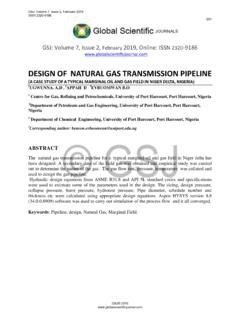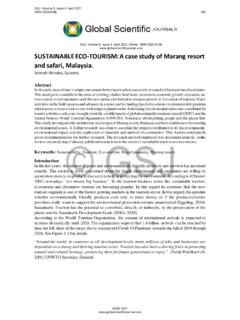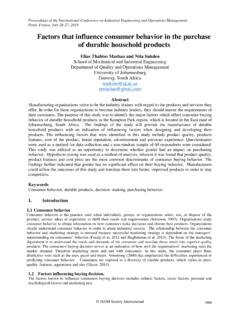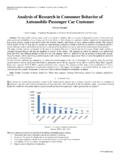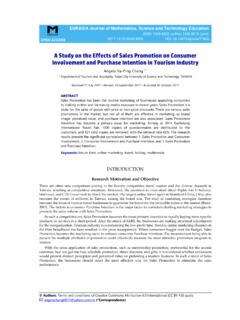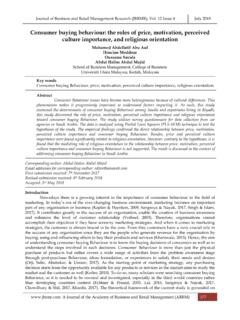Transcription of IMPACT OF ONLINE SHOPPING ON CONSUMER BUYING …
1 GSJ: Volume 7, Issue 11, November 2019, ONLINE : ISSN 2320-9186 IMPACT OF ONLINE SHOPPING ON CONSUMER BUYING BEHAVIOUR: A CASE STUDY OF JUMIA KENYA, NAIROBI Eunice Njoki Kibandi The Management University of Africa Email: James Mwikya Reuben The Management University of Africa Email: The growth and spread of internet with an extraordinary pace over the last few decades has resulted in emergence of ONLINE purchasing of products and services. This study will focus on the IMPACT of ONLINE SHOPPING on CONSUMER BUYING behaviour; A case study being Jumia. The study proposed four objectives which were to assess how perceived benefits, perceived risks, product awareness and website design influence ONLINE BUYING behaviour of Jumia customers. Theoretical framework that guided the study were Technological Acceptance Model (TAM) and Theory of Planned Behaviour (TPB) which are relevant to this study and is operationalized through a conceptual framework.
2 The research design that was applied in this research was descriptive research design. The target population for the study was customers of Jumia based in Nairobi. Purposive random sampling was used to take a sample of 94 customers of Jumia ONLINE store products who could be found within Nairobi CBD. Statistical Package for Social Sciences (SPSS) version 25 and Microsoft excel package was used for data analysis and findings were presented in tables. Correlation analysis was done to test the relationship between the three independent variables that is; perceived benefits of ONLINE SHOPPING , perceived risks of ONLINE SHOPPING , product awareness and website design and the dependent variable ONLINE CONSUMER BUYING behavior. The results showed that perceived Risks of ONLINE SHOPPING had a significant positive linear relationship with the customer BUYING behavior at 5% level of significance, r = ; p= Regression analysis was also conducted and the results indicated that the independent variables were found to explain of the variation in the Customer BUYING behavior as indicated by a coefficient of determination (R2) value of study recommends that various risk-reducing strategies should be developed by ONLINE retailers in addition to putting mechanisms in place to guarantee the quality of their merchandise and create avenues of settling disputes.
3 Another recommendation is that ONLINE vendors should give less priority to website design since GSJ: Volume 7, Issue 11, November 2019 ISSN 2320-9186 116 GSJ 2019 consumers rarely focus on visual design, site content, ordering and transaction procedure in making purchase decision via the internet. Key words: ONLINE SHOPPING , CONSUMER behaviour, Jumia, Nairobi County. 1. INTRODUCTION ONLINE SHOPPING and ONLINE Stores SHOPPING is probably one of the oldest words or terms used to describe what we have all been doing over the years. Then again, in ancient times, the terms that would have been used would be trading or bartering and probably even market. However, the internet has opened up a wider and more exciting market to the new generation of consumers. ONLINE SHOPPING is any form of sale that is done over the internet (Celine, 2013).
4 The study of CONSUMER decision making processes is important because of the complex global development in all fields and marketing have forced marketers to make their works purposeful (Jones Christensen et al., 2015). Nowadays, ONLINE SHOPPING has been rapidly expanding as a new communication channel and has been competing with traditional channels (Kim & Peterson, 2017). In addition, any company, which invests in ONLINE SHOPPING , will see a large number of rivals shortly (Clemons et al., 2016). Observed growth in ONLINE sales can be considered as a part of the Internet benefits due to provision of a high volume of quick and inexpensive information (Lee & Dion, 2012). Problem statement Internet usage in Kenya has been growing fast. According to a report by the Communication Authority of Kenya, the value of ecommerce in Kenya is at billion compared to South Africa s Sh54 billion while in Egypt and Morocco it is about Sh17 billion and billion respectively (Mark, 2014).
5 Ngugi (2014) states that ONLINE SHOPPING has also been growing at a Very fast pace in the developed world, but the trend has not quite picked up in the developing nations, including Kenya. This is a great niche for companies to invest in establishing their businesses ONLINE . However, many companies in Kenya are still reluctant and they question the benefits of ONLINE GSJ: Volume 7, Issue 11, November 2019 ISSN 2320-9186 117 GSJ 2019 presence. This is because there is increased competition to attract CONSUMER s attention ONLINE . Consumers nowadays have become part time marketers. They understand marketing and they wants brands to be honest. Notably, most consumers are still scared of money lost through unscrupulous deals and credit/ debit card fraud. Consumers also have perceived risks which affect their attitude and also their past experiences affects their BUYING behaviour.
6 Specific Objective i. To assess how perceived benefits of ONLINE SHOPPING influences ONLINE BUYING behaviour of Jumia customers. ii. To examine how perceived risks of ONLINE SHOPPING influences ONLINE BUYING behaviour of Jumia customers. iii. To find out how product awareness influences ONLINE BUYING behaviour of Jumia customers. Conceptual Framework Independent Variable Dependent Variable Figure 1 Conceptual Framework 2. LITERATURE REVIEW Theoretical Review Technological Acceptance Model Technological Acceptance Model (TAM) was introduced by Fred Davis in 1986 and specifically tailored for modelling user acceptance of information systems. TAM is an adaptation of the Theory of Reasoned Action (TRA) by Davis in 1989 (Davis, Bagozzi, & Warshaw, 1989). It is one of the most successful measurements for computer usage effectively among practitioners and academics.
7 TAM attempts not only to predict but also provide an explanation to help researchers and practitioners identify why a particular system may be unacceptable and pursue appropriate steps. ONLINE SHOPPING CONSUMER ONLINE BUYING Behaviour GSJ: Volume 7, Issue 11, November 2019 ISSN 2320-9186 118 GSJ 2019 TAM helps to understand how users of the technology come to accept a certain technology. This model postulates that when individuals are presented with a new technology, several factors affect when and how they will use it. This include perceived usefulness (PU) and perceived Ease of use (PEOU). perceived Usefulness as defined by Fred Davis is the degree to which an individual believes that using a certain technology will increase his or her job performance. perceived ease of use can be defined as the degree to which an individual believes that the system will be free from effort (Davis, 1989).
8 This theory has attracted the attention of scholars and has been continuously studied and expanded. An important factor in TAM is to trace the IMPACT of external factors on internal beliefs, attitudes and intentions whose purpose is to assess the user acceptance of emerging information technology. Two particular beliefs are addressed through TAM perceived usefulness (PU) and perceived ease of use (PEOU). perceived usefulness (PU) is the prospective user s subjective probability that using a specific application system will increase his or her job performance within an organizational context. perceived ease of use (PEOU) is the degree to which the prospective user expects the target system to be free of effort. This study aims to test the applicability of TAM in predicting ONLINE BUYING behaviour of Jumia customers in Nairobi County.
9 Despite its frequent use, TAM has a few shortcomings. TAM has a limited predictive power and it lacks any practical value. TAM "has been accused of diverting researchers attention away from handling other important research matters and has created an illusion of progress in knowledge accumulation. (Chuttur, 2009). Other researchers says that the attempt to expand TAM in order to accommodate factors such as environment and information technology has led to a state of confusion and chaos. (Benbasat & Barki, 2007) On the other hand other researchers claim that TAM and TAM2 account for only 40% of a technological system's use. Empirical Review ONLINE SHOPPING and CONSUMER BUYING behaviour GSJ: Volume 7, Issue 11, November 2019 ISSN 2320-9186 119 GSJ 2019 Previous research have shown that convenience and time saving are the main reasons that motivate consumers to shop ONLINE (Chen, Hsu, & Lin, 2010).
10 Convenience means SHOPPING practices using the internet that can reduce time and effort of the consumers in the BUYING process. ONLINE SHOPPING has enabled finding merchants easier by cutting down on effort and time (Schaupp & Belanger, 2005). Research also demonstrated that ONLINE SHOPPING is better than conventional SHOPPING due to convenience and ease of use (Nazir et al., 2012). In a previous study done on adoption and usage of ONLINE SHOPPING , it was established that attitude towards ONLINE SHOPPING depends upon the view of the consumers regarding the activities carried out on the internet as opposed to conventional SHOPPING environments (Soopramanien & Robertson, 2007). Thus, a CONSUMER who perceives ONLINE SHOPPING as beneficial is more inclined to make ONLINE purchases.


